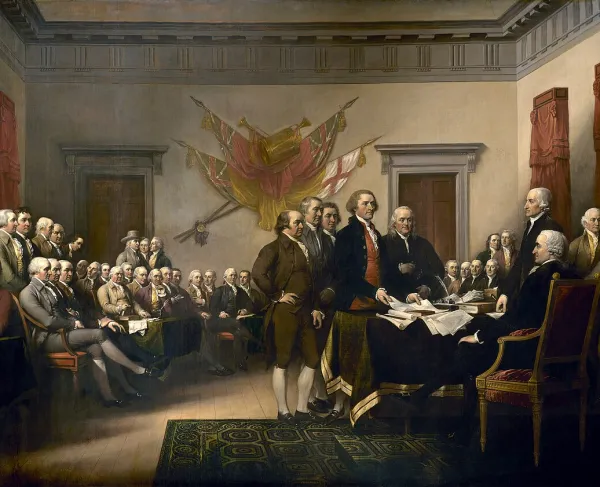Centennial Reflections: Cowpens National Battlefield Park

John Slaughter, Southern Campaign of the American Revolution Group Superintendent, reflects on this Revolutionary War battlefield in celebration of 100 years of the National Park Service.
Gaffney, S.C. | January 17, 1781 | Federal Battlefield Park since 1929 | 791 Acres
“I am heading out to visit a battlefield in South Carolina.”
Most Americans hearing this statement would automatically assume that the visit will take you to the site of a confrontation between brothers or cousins clad in grey and blue during the 1860s. But that deduction would only be partially correct.
While you would be right that the battle in question came from a civil war, you might be heading to the wrong century: the uniforms could just as easily be red or blue, or even rustic hunting frocks. You might, in fact, be heading to tour a site from America’s FIRST civil war, one between those loyal to the Crown of England and those committed to the principles of freedom and democracy.
The Southern Campaign(s) of the American Revolutionary War is arguably the most misunderstood and under-taught segment of our nation’s founding history. Yet, to many scholars, it is where the Revolutionary War was won. More battles and skirmishes took place in South Carolina than in any other colony — nearly a third of all engagements during the course of the war — but they are overshadowed by clashes in the Northeast.
A new grouping of National Park Service (NPS) units is designed to highlight the contributions of the southern colonies and more fully integrate them into the complete story of our founding “patriot spirit.” This unique approach to park management and interpretation focuses shared efforts and resources toward promoting the host of related sites — publicly and privately owned — across Georgia, the Carolinas, Tennessee and Virginia.
The Southern Campaign of the American Revolution Parks Group consists of Cowpens National Battlefield (NB), Kings Mountain National Military Park (NMP), Ninety Six National Historic Site (NHS) and Overmountain Victory National Historic Trail (NHT). Each of these, as part of the tapestry of places and people that helped secure American independence, help visitors discover and unwrap the “rest of the story.”
The frontier village of Ninety Six was established in 1751 as a Cherokee trading post and eventual backcountry crossroads. On November 19, 1775, 1,900 loyalists attacked a garrison of 600 patriots at Ninety Six. In the first land battle south of New England, James Birmingham became the first southern patriot to give his life for the cause of freedom. Ninety Six NHS is also the site of the longest siege of the Revolutionary War (May 21–June 18, 1781) and is home to the war’s only extant earthen Star Fort, plus a tunnel designed and implemented by renowned Rev War military engineer, Thaddeus Kosciuszko.
By 1778, with the war in the north at a stalemate, England turned its eyes to the south. By September 1780, the tactic seemed to be working — the loyalists held Georgia and most of South Carolina. A powerful army under Gen. Charles Lord Cornwallis was poised to re-establish southern royal colonies, march north to join other British troops along the Chesapeake Bay, claim the seaboard and crush the patriot forces of the north.
But when Major Patrick Ferguson, commander of Cornwallis’s left offensive — comprised entirely of southern colonist militia loyal to the Crown — put forth an ultimatum to settlers west of the Blue Ridge: “Quit opposing British arms, or I will march my army over the mountains, hang your leaders, and lay your county to waste with fire and sword,” it was met with unanticipated patriot spirit among the Scots-Irish in the backcountry. The “Overmountain Men” gathered from across the region and marched to bring the fight to the British at Kings Mountain, S.C. The complete patriot victory on October 7, 1780, was recalled by British General Sir Henry Clinton as “The first link in a chain of evils that…ended in the total loss of America.”
On January 17, 1781, General Daniel Morgan led his army of seasoned Continentals and backwoods militia to a brilliant and total victory over Cornwallis’s army’s right arm, the elite British legion commanded by “Bloody” Banastre Tarleton on a field called the Cow Pens. Gen Morgan utilized the expert marksmanship of the militia riflemen and the bravado of the British legion to take the field in what is still studied by U.S. military officers as a tactical masterpiece resulting in a “double envelopment” and total routing of the British forces.
Within the year, after a draw at Guildford Court House, N.C., Cornwallis was forced to surrender the British forces at Yorktown, essentially ending the British rule of the North America and setting into motion the founding of this great nation.
The Southern Campaign of the American Revolution Parks Group is honored to work in tandem with the Revolutionary War Trust (formerly Campaign 1776), a division of the American Battlefield Trust, to share these places and the stories of this relatively unknown segment of our nation’s history. This expanded partnership between the National Park Service and the Revolutionary War Trust is geared to change the way America preserves and understands our Revolutionary War history and ensure that future generations garner a deeper understanding and ownership of that same patriot spirit.





